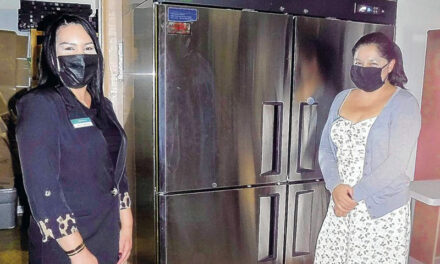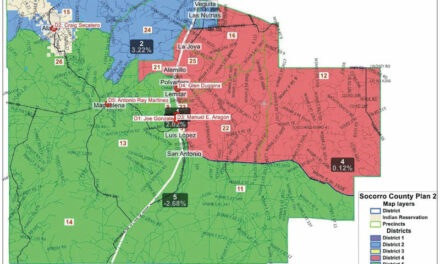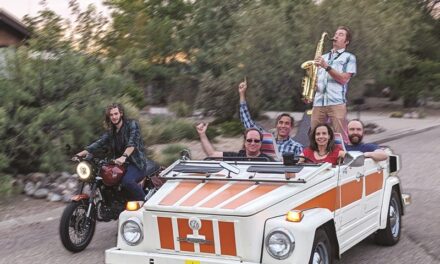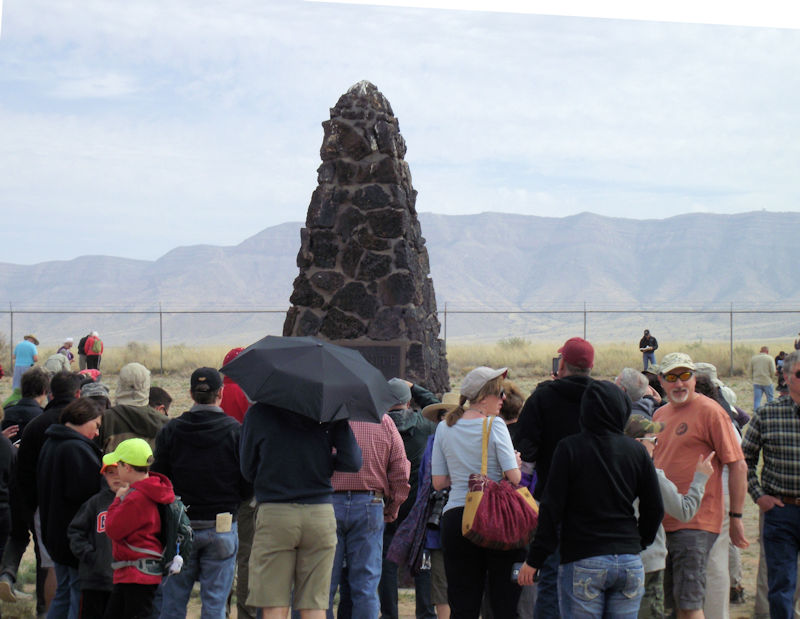
The monument marking Ground Zero is the usually the first stop visitors make during the Trinity Site Open House.
John Larson | El Defensor Chieftain photos
Perhaps the most significant event in Socorro County – not to mention world history – took place 27 miles southeast of San Antonio on ranch land acquired by the U.S. Army. Dubbed Trinity, the July 16, 1945 event signaled the birth of the nuclear age with the testing of the first atomic bomb on what was then known as the Alamogordo Bombing Range.
This Saturday, Oct. 2, White Sands Missile Range will open Trinity Site to the public after a brief pause in activities due to COVID-19. Visitors can once again examine first-hand Ground Zero and the George MacDonald ranch house where the plutonium core was assembled by J. Robert Oppenheimer and other physicists.
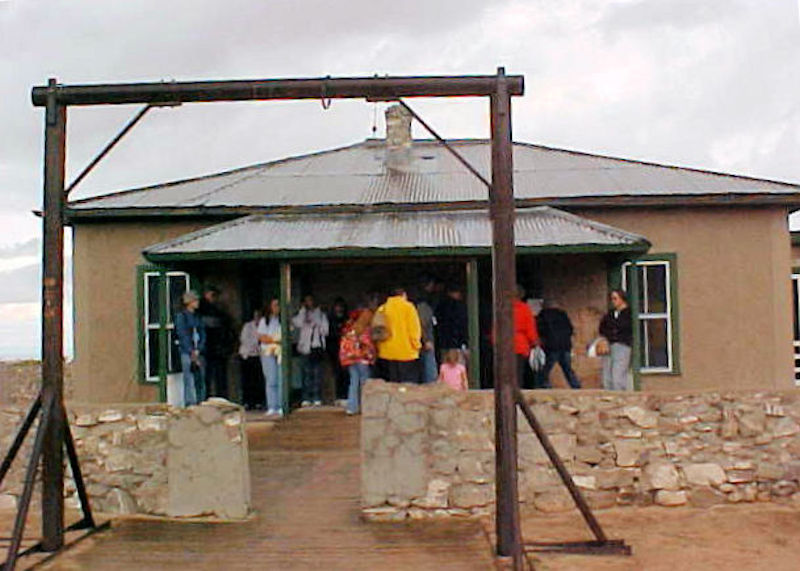
A shuttle bus takes visitors two miles from Ground Zero to the MacDonald Ranch House where the bomb was
assembled.
The test was the culmination of three years work. The nuclear age was born in Los Alamos, as part of the Manhattan Project, along with a uranium enrichment plant in Oak Ridge, Tennessee, and a plutonium plant in Richland, Washington.
Before the beginning of World War II, physicists had already been experimenting with splitting the atom.
In an August 1939 letter to then-President Franklin Roosevelt, Albert Einstein indicated that German scientists may be trying to develop an atomic bomb.
“In the course of the last four months it has been made probable – through the work of Joliot in France as well as Fermi and Szilard in America – that it may become possible to set up a nuclear chain reaction in a large mass of uranium, by which vast amounts of power and large quantities of new radium-like elements would be generated,” Einstein wrote. “Now it appears almost certain that this could be achieved in the immediate future.
“This new phenomenon would also lead to the construction of bombs, and it is conceivable – though much less certain – that extremely powerful bombs of a new type may thus be constructed. A single bomb of this type, carried by boat and exploded in a port, might very well destroy the whole port together with some of the surrounding territory. However, such bombs might very well prove to be too heavy for transportation by air.
“…I understand that Germany has actually stopped the sale of uranium from the Czechoslovakian mines which she has taken over. That she should have taken such early action might perhaps be understood on the ground that the son of the German Under-Secretary of State, von Weizaecker, is attached to the Kaiser-Wilhelm-Institut in Berlin where some of the American work on uranium is now being repeated,” Einstein wrote.
In 1942 the Manhattan Project began and within three years the first bombs were produced.
The Trinity Site open house includes ground zero and the George MacDonald ranch house, two miles to the south, where physicist J. Robert Oppenheimer oversaw the assembly of what was referred to as the “gadget,” or the “device.”
Visitors will also be able to experience what life was like for a ranch family in the early 1940s.
The restored house adds to the ambiance of the Trinity Site visit, where people are able to not only learn about World War II and nuclear history but study the lifestyles of ranchers on the isolated section of the northernmost stretch of the Chihuahuan Desert.
Such historic items as a cistern and a windmill-fed swimming pool at the ranch house help today’s visitors understand time and distance in the area. A crudely painted sign on the door, asking scientists who were assembling the core to “wipe your feet” before entering. Today it draws guffaws among visitors who are aware of the degree of cleanliness required in “clean rooms” of computer chip manufacturers and other high-tech ventures.
To comply with the New Mexico Governor COVID-19 mandates, masks must be worn while inside the buses and the ranch house.
The 20-kiloton shot was equivalent to eight million sticks of dynamite.
Manhattan Project Lt. Col. Ralph Smith of Los Alamos, observing from the present day Stallion Range Center area wrote in 1945 that a “ball of fire seemed to rise in something of toadstool effect. Later the column proceeded as a cylinder of white smoke.
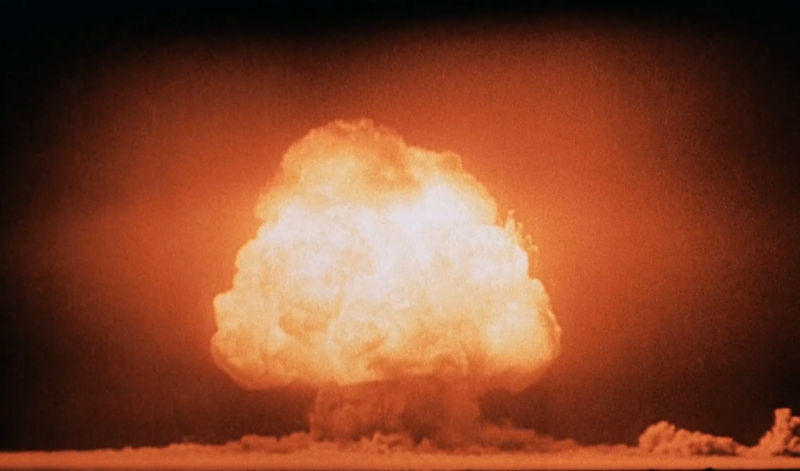
Witnesses say the detonation of the “gadget” was brighter than the sun.
Courtesy of the U.S. Department of Energy
“I was staring straight ahead with my open left eye covered by a welders glass and my right eye remaining open and uncovered,” Smith wrote. “Suddenly, my right eye was blinded by a light which appeared instantaneously all about without any build-up of intensity. My left eye could see the ball of fire start up like a tremendous bubble or nob-like mushroom. I dropped the glass from my left eye almost immediately and watched the light climb upward. The light intensity fell rapidly hence did not blind my left eye but it was still amazingly bright. It turned yellow, then red, and then beautiful purple. At first, it had a translucent character but shortly turned to a tinted or colored white smoke appearance.”
Smith estimated the ball of fire to be one to two miles wide.
“Someone said keep your mouth open and just then, about two minutes after the light flash, a sharp loud crack swept over us. It reverberated through the mountain like thunder. Several small flashes took place some distance from and after the big flash, apparently part of a measuring system.”
But not all witnesses to the event were connected with the Manhattan Project. The late Holm Bursum III said in a 2012 interview he was staying on his family’s Adobe Ranch in the summer of 1945.
According to other sources, the 10-year-old Holm and others in the ranch house were the closest civilians to the blast – only 16 miles – on the morning of July 16.
“Highway 380 cuts through the center of our old ranch,” Bursum said. “The military had taken over the south portion – one half of the ranch – from 380 down to three miles north of what is now the Trinity Site. In fact, 99 ranchers were displaced. The military said the ranches would be returned three years after the end of the war. They never were.”
Bursum said he spent his first eight years on the ranch and spent most summers there throughout his youth.
“I was on the ranch that summer, staying at the old stagecoach stop called Ozzane,” he said. “In the old days, a stagecoach from White Oaks came through there on its route to San Antonio.”
“I was staying at the Adobe place, four miles east of Bingham and 16 miles north-northeast of the shot,” Bursum said. “The army had blocked part off the highway (Highway 380), and there was a military presence in San Antonio. We later learned they were there to evacuate Socorro if the radioactive cloud blew over it.”
The test was scheduled for midnight, but because of a big thunderstorm was rescheduled for just before sun up.
At 16 miles away it shook the building in which Bursum was sleeping.
“I slept in a top bunk in a bunk bed against the south wall of the Adobe place that morning, and it woke me up,” he said. “It shook the house pretty good and rattled all the cans, and it was bright as morning.
“For a minute I thought the sun was coming up in the south,” he said. “We had no idea what it was. It was announced later that an ammunition dump had blown up.”
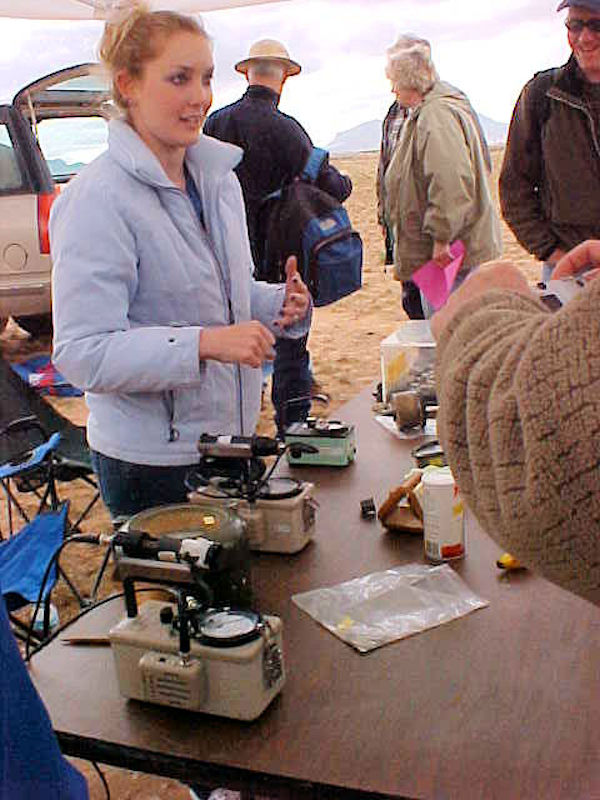
Volunteers explain the workings of a Geiger counter.
After 76 years there is practically no trace of that blast to be seen, except for a crumbled concrete footing of the 100-foot tower – a surplus Forest Service fire watchtower – from which the bomb was detonated. The large stone and mortar obelisk is just about all there is to see.
Although radiation levels are low, some feel any extra exposure should be avoided. The decision is yours. It should be noted that small children and pregnant women are potentially more at risk than the rest of the population and are generally considered groups who should only receive exposure in conjunction with medical diagnosis and treatment. Again, the choice is yours.
Typical radiation exposures for Americans per the American Nuclear Society:
- One hour at Trinity Site ground zero – one half mrem
- Cosmic rays from space – 47 mrem at Denver per year, 28 mrem at St. Louis
- Radioactive minerals in rocks and soil – 63 mrems per year on Colorado Plateau
- Radioactivity from air, water and food – about 240 mrem per year
- About six mrem per chest X-ray, 65 mrem per hip X-ray, and 110 mrem for a CAT Scan
- Watching television – less than one mrem per year
- Wearing a plutonium-powered pacemaker – 100 mrem per year
The first Trinity Site open house was in September 1953 with about 650 people in attendance.
Nowadays, the Site is open to the public only two days each year; on the first Saturday of April and October. At the site visitors can take a quarter-mile walk to ground zero where a small obelisk marks the exact spot where the bomb was detonated. Historical photos are mounted on the fence surrounding the area. Food and memorabilia vendors will be on site.
The open house is from 8 a.m. to 3:30 p.m. The Stallion Gate entrance will be closed to late arrivals at 2 p.m.
The White Sands Missile Range Stallion Gate turnoff on Highway 380 is 12 miles east of San Antonio. From there it’s another 20-mile drive to ground zero.

